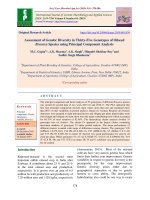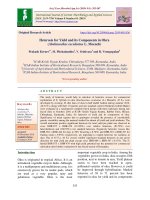Component analysis of genetic variance in okra (Abelmoschus esculentus L. (Moench)
Bạn đang xem bản rút gọn của tài liệu. Xem và tải ngay bản đầy đủ của tài liệu tại đây (218.68 KB, 5 trang )
Int.J.Curr.Microbiol.App.Sci (2019) 8(4): 2681-2685
International Journal of Current Microbiology and Applied Sciences
ISSN: 2319-7706 Volume 8 Number 04 (2019)
Journal homepage:
Original Research Article
/>
Component Analysis of Genetic Variance in
Okra (Abelmoschus esculentus L. (Moench)
M.I. Makdoomi*, Kouser P. Wani, K. Hussain, Ambreen Nabi, Ajaz A. Malik,
Ummaiyaih H. Masoodi and M. Mudasir Magray
1
2
KVK, budgam, India
Division of Vegetable Science, Sher-e-Kashmir University of Agricultural Sciences and
Technology of Kashmir, Shalimar, Srinagar – 190 025 (J&K), India
*Corresponding author
ABSTRACT
Keywords
Genetic variance,
Okra, Lady finger,
Genetic parameters,
Recessive alleles
Article Info
Accepted:
20 March 2019
Available Online:
10 April 2019
The estimates of components of genetic variation in okra revealed that additive component
ˆ ) was significant for all traits i.e. days to first flowering, days to first pod picking, plant
(D
height, number of nodes, internodal length, pod length, pod girth, avg. pod weight, number
of pods per plant, pod yield per plant (g), number of seeds per pod, 100 seed weight (g),
seed yield per plant (g) and pod yield (t/ha). Both the components of dominance variance
ˆ
ˆ
( H 1 and H 2 ) were significant for all the traits and were much higher in magnitude than
ˆ ), thus revealing the importance of nonthe corresponding additive components ( D
2
additive gene action in the inheritance of traits under study. Net dominance effect ( hˆ )
was found to be positive and significant for all traits except 100 seed weight in all the
environments as well as in data pooled over environments. The Fˆ value was positive and
significant for days to first flowering, days to first fruit picking, number of nodes,
internodal distance, plant height, pod length, pod girth, number of pods per plant, pod yield
per plant and seed yield per plant indicating the role of dominant alleles towards
dominance variance and non significant for average pod weight, number of seeds per pod,
100 seed weight and pod yield revealing the role of recessive alleles towards dominance
deviation.
Introduction
Okra or lady finger (Abelmoschus esculentus
L. (Moench) is an annual vegetable crop
grown from seed in tropical and subtropical
parts of the world its tender green fruits are
used as a vegetable and are generally
marketed in fresh state, but sometimes in
canned or dehydrated form the recent surge in
widespread adoption of hybrids by farmers
necessitates the development of new and
higher yielding hybrids which are able to
realise the high degree of economic heterosis.
Several biometrical procedures are available
for evaluation of parents and their crosses and
to know the nature and magnitude of gene
effects for expression of various metric traits.
Diallel analysis as suggested by Griffing
(1956) and Hayman (1954) are sufficient
enough to generate basic information on
2681
Int.J.Curr.Microbiol.App.Sci (2019) 8(4): 2681-2685
nature of inheritance of traits and to assess the
combining ability of parents. It also helps to
obtain information about genetic systems
governing the inheritance of attributes to be
improved, to assess the potential of different
crosses and also to predict their performance
in subsequent generations. It helps in
formulating a coherent breeding methodology
for crop improvement.
In the present study, diallel analysis over
environments as proposed by Singh (1973)
has been used to obtain information on
combining ability, gene action and genetic
parameters. Keeping all the facts under
consideration, present investigation, involving
a diallel crossing programme on ten diverse
lines of okra, was initiated to generate
information on the nature and magnitude of
gene action for morphological, yield and yield
attributing traits.
Materials and Methods
The
present
investigation
entitled
“Component analysis of genetic variance in
okra [Abelmoschus esculentus L. (Moench)]
was conducted during Kharif 2012 at three
different
locations
viz.,
Vegetable
Experimental Farm, SKUAST-Kashmir,
Shalimar; Mountain Research Centre for Field
Crops, Khudwani and Regional Research
Station and Faculty Of Agriculture, Wadura..
The basic materials consisted of ten diverse
genotypes of okra viz.SKBS-11, Pant bhindi,
IC-117018, Azad Ganga, Parbhani kranti,
Lam-1, GO-2, Red Bhindi, Arka Anamika
and Pusa Sawani. Forty five F1 crosses were
generated through 10 x 10 diallel mating
design at Vegetable Experimental Farm,
Division of Vegetable Science, SKUASTKashmir, Shalimar during the year 2011. The
final experimental materials consisting of ten
parents and forty five F1 crosses were
evaluated during year 2012 at three locations.
At each location the experiment was laid out
in completely randomized block design with
three replications. The row to row and plant to
plant spacing was maintained at 45 x 25 cm.
Recommended package of practices were
adopted to raise a healthy crop at all the
locations
The observations like days to first flowering,
days to first pod picking, plant height (cm),
number of nodes, internodal length (cm), pod
length (cm), pod girth (cm), avg. pod weight
(g), number of pods per plant, pod yield per
plant (g), number of seeds per pod, 100 seed
weight (g), seed yield per plant (g) and pod
yield (t/ha) were recorded.
Results and Discussion
The pooled data estimates of components of
genetic variance and their corresponding
standard errors for the traits have been
presented in the table 1.1 and 1.2 while as the
proportion of related genetic parameters along
with the estimates of average degree of
dominance and heritability in narrow sense
are presented in the table 2. The results are
presented as follows:
Genetic variances are used for working out
various genetic parameters. Six components
of variance were worked out i.e., additive
variance (D), dominance variance (H1),
proportion of positive and negative genes in
parents (H2), expected environmental
component (E), mean of Fr over the array (F)
and dominance effect (h2).
These estimates were used to generate some
genetic ratios i.e., average degree of
ˆ
dominance ( H 1 / Dˆ ) 1/2, ratio of dominant and
recessive genes in the parents [(4DH1)1/2 +
F]/[(4DH1)1/2-F], the number of gene groups
(h2/H2) and the proportion of positive and
negative genes (H2/4H1).
2682
Int.J.Curr.Microbiol.App.Sci (2019) 8(4): 2681-2685
Table.1.1 Estimates of components of genetic variation for various traits in Okra (Abelmoschus esculentus L. Moench)
Table-1.1:
Estimates of components of genetic variation for various traits in Okra (Abelmoschus esculentus L. Moench)
Components
Days to first
Days to first fruit
Number of
Internodal
Plant height
Pod length
flowering
picking
nodes
distance
Pooled
Pooled
Pooled
Pooled
Pooled
Pooled
8.95**±2.34*
11.62**±2.42
6.12**±1.05
0.95**±0.25
528.21**±40.34
0.61**±0.11
Dˆ
Pod Girth
Pooled
0.25**±0.04
Hˆ 1
Hˆ
31.52**±7.12
29.94**±5.06
10.21**±2.16
2.51**±0.49
543.51**±86.45
28.36**±3.64
29.83**±3.65
9.38**±1.76
1.95**±0.32
416.46**±72.67
2.95** ±0.52
0.61**±0.07
hˆ 2
5.12*± 2.12
7.16*± 3.57
4.67**±1.24
1.34**±0.31
348.21**±48.91
2.17**±0.32
0.24**±0.04
Fˆ
Eˆ
8.62*± 4.28
10.81*±5.15
1.82*±0.42
1.41*±0.39
490.37**±92.58
0.58*±0.21
0.37*
±0.13
0.25± 0.71
0.26±0.61
0.14±0.29
0.02±0.05
0.29±12.21
0.04
±0.01
2
4.93**±0.38
0.04
0.61**±0.12
±0.06
*,** significant at 5 and 1% level of significance
Table.1.2 Estimates of components of genetic variation for various traits in Okra (Abelmoschus esculentus L. Moench)
Table-1.2:
Estimates of components of genetic variation for various traits in Okra (Abelmoschus esculentus L. Moench)
Components
Average pod
Number of pods Pod yield plant-1
Number of seeds
100 seed
Seed yield plant-1
weight
plant-1
plant-1
weight
Pooled
Pooled
Pooled
Pooled
Pooled
Pooled
0.62** ±0.27
5.67**±0.95
494.21*±200.34
65.25**±11.64
0.19**±0.03
315.01**±46.23
Dˆ
Total pod yield
Pooled
2.59*±1.16
Hˆ 1
2.67**±0.62
10.36**±1.97
208*±48.21
180.36**±30.58
0.37**±0.07
634.25**±53.21
11.94**±2.61
Hˆ 2
2.24**±0.54
8.67** ±1.72
127.32*±57.24
146.25**±23.95
0.29**±0.05
487.32**±81.24
10.61**±2.14
hˆ 2
2.64**±0.32
5.67**±1.09
124.25*±46.32
119.25**±17.85
0.07±0.04
152.32*±65.24
2.27*± 1.12
Fˆ
Eˆ
0.96± 0.67
2.62*± 1.13
368.32**±46.31
42.36± 33.08
0.08±0.05
455.31**±119.82
1.71±2.58
0.01±0.07
0.19±0.24
0.41±4.36
0.01±0.01
7.69± 6.21
*, ** significant at 5 and 1% level of significance
2683
1.38±11.24
0.06±0.31
Int.J.Curr.Microbiol.App.Sci (2019) 8(4): 2681-2685
Table.2 Proportion of related genetic parameters of variation for maturity and yield attributing
traits in okra (Abelmoschus esculentus L. Moench) (pooled)
S.No.
1
2
3
4
5
6
7
8
9
10
11
12
13
14
Proportion
Days to first flowering
Days to first fruit picking
Plant height
Number of nodes
Internodal distance
Pod length
Pod girth
Average pod weight
Number of pods plant-1
Pod yield plant-1
Number of seeds pod-1
100 seed weight
Seed yield plant-1
Pod yield
Hˆ
[ 1 ]½
Dˆ
Hˆ 2
4 Hˆ
KD
1.87
1.59
1.014
1.329
1.568
2.694
1.593
2.009
1.291
2.546
1.632
1.694
2.261
2.418
0.22
0.24
0.191
0.220
0.191
0.251
0.191
0.221
0.237
0.229
0.218
0.202
0.203
0.229
2.16
2.47
2.713
1.256
2.198
1.739
2.425
1.175
1.269
1.417
1.452
1.419
2.357
0.566
KR
1
Perusal of data pooled over environments
indicated that additive genetic variance
component ( Dˆ ) was significant for all traits
under study. Measures of dominance
components ( Hˆ 1 and Hˆ 2 ) were significant for
all the traits. These results indicated the
involvement of both additive and dominance
components in the inheritance of these traits.
However, the magnitude of dominance
components, in general, was higher than the
corresponding additive component. This
suggests the greater role of dominance
component in the inheritance of these traits.
Similar observations were also reported by
Vachhani and Shekhat (2008) and Shashank
et al., (2012). A preponderance of dominant
gene action over the additive one was also
observed for all traits. Vachhani and Shekhat
(2008) observed similar gene action for yield
and its attributing traits. Asymmetrical
distribution of genes with positive and
negative effects in the parents was observed
in all traits in the present study. In such a
situation, the non-additive genetic variance
hˆ 2
Hˆ
Heritability
(n.s)
0.18
0.24
0.49
0.68
0.83
0.73
0.39
1.17
0.65
0.61
0.81
0.24
0.31
0.21
0.25
0.26
0.437
0.548
0.559
0.485
0.151
0.249
0.527
0.269
0.449
0.486
0.566
0.328
2
could be justified by either the dominance or
the over dominance effects of genes in
heterozygous position. The net dominance
effects (h2) was significant and positive for all
traits, suggesting significant high dominance
effects in the heterozygote over all loci and
positive direction of dominance for these
traits. (F) values were found to be positive
and significant for days to first flowering,
days to first fruit picking, number of nodes,
internodal distance, plant height, pod length,
pod girth, number of pods per plant, pod yield
per plant and seed yield per plant, depicting
higher frequency of dominant alleles in the
parents with respect to these traits. For rest of
traits, (F) values were positive but non
significant, depicting the relative frequency of
dominant and recessive alleles in the parents
was proportionally equal. Vachhani and
Shakhat (2008) reported similar observations
in a diallel cross of okra. The average degree
ˆ
of dominance ( H 1 / Dˆ ) 1/2 was greater than
unity in all characters, indicating over
dominance in the expression of these traits.
2684
Int.J.Curr.Microbiol.App.Sci (2019) 8(4): 2681-2685
The estimate of (H2/4H1) was less than 0.25 in
all traits, revealing asymmetrical distribution
of genes in parents with respect to these traits.
The value of KD/KR ratio was greater than
unity in all traits, indicating excess of
dominant alleles as compared to recessive
alleles. The estimate of (h2/H2) was greater
than 0.50 for number of nodes, internodal
distance, pod length, average pod weight,
number of pods per plant, pod yield per plant
and number of seeds per pod, indicating
greater proportion of dominant genes/ gene
groups for these traits, whereas for rest of the
traits, the valve was less than 0.50 indicating
greater proportion of recessive genes. The
heritability (n.s.) estimates for days to first
flowering, days to first pod picking, pod girth,
average pod weight, pod yield per plant was
low(10-25%); whereas for rest of traits,
heritability (n.s.) estimates were medium(3055%). The low to medium heritability (n.s.)
indicated the major role of non-additive gene
action in the inheritance of most of the
characters and limited scope of their
improvement through straight selection.
Similar results were also reported by
Srivastava et al., (2008), Indurani et al.,
(2002) and Vachhani and Shekhat (2008).
References
inheritance. Heredity 10: 31-50.
Hayman, B.I. 1954b. The analysis of variance
of diallel table. Biometrics 10: 235244.
Indurani, C.; Veeraraghavathathan, D. and
auxeillia, J. 2003. Studies on the
development of F1 hybrids in okra
with high yield and resistance to
yellow vein mosaic virus.
South
Indian Horticulture. 51(1-6): 219-226.
Shashank, S. Solankey, R.K. Singh, Sanjay K.
Singh, D.K. Singh, V.P. Singh,
Prakash Singh. 2012. Nature of gene
action for yield and yield attributing
traits in okra (Abelmoschus esculentus
(L.) Moench). The Asian Journal of
Horticulture. 7(2): 321-323
Singh, D. 1973. Diallel cross analysis for
combining ability over different
environments-II. Indian Journal of
Genetics and Plant Breeding 33 (3):
469-481.
Srivastava, M.K., Kumar, S., Pal, A.K. 2008.
Studies on combining ability in okra
through diallel analysis. Indian
Journal of Horticulture 65(1): 348351.
Vachhani, J.H. and Shekhat H.G. 2008. Gene
action in Okra. Agriculture Science
Digest. 28(2): 84-88.
Griffing, B. 1956. A generalized treatment on
the use of diallel cross quantitative
How to cite this article:
Makdoomi, M.I., Kouser P. Wani, K.Hussain, Ambreen Nabi, Ajaz A. Malik, Ummaiyaih H.
Masoodi and Mudasir Magray, M. 2019. Component Analysis of Genetic Variance in Okra
(Abelmoschus esculentus L. (Moench). Int.J.Curr.Microbiol.App.Sci. 8(04): 2681-2685.
doi: />
2685
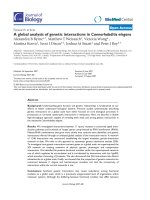
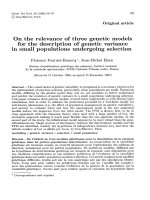
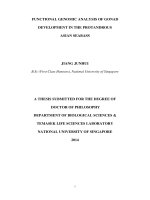
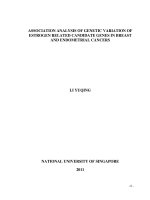

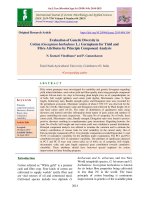
![Genetic variability studies in F2 segregating populations for yield and its component traits in Okra [Abelmoschu sesculentus (L.)Moench]](https://media.store123doc.com/images/document/2020_01/13/medium_nxs1578931693.jpg)
![Effect of precision farming techniques involving fertigation and mulching on growth attributes and seed yield of okra var. Arka Anamika [Abelmoschus esculentus (L.) Moench]](https://media.store123doc.com/images/document/2020_01/14/medium_ynr1578936108.jpg)
